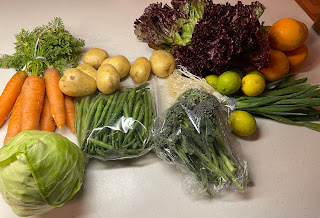In 2009 I started getting fruits and veggies from a CSA (community supported agriculture). This is a farm in my county that puts out a weekly or bi-weekly box of produce. I get one every other week. For about $30 I get a box with a dozen or so different kinds of items. I'm lucky enough to live in Southern California, so the variety and quality of this locally grown and organic produce is wonderful.
 |
| My February 2023 CSA Box Contents |
I still need to remember to pick up my bi-weekly veggie box. (In all honesty, my husband is usually the one who picks it up from a neighbor's porch a few blocks away.) And I still spend time unpacking and processing the contents. But I like the serendipity of discovering that I like things I would never have chosen to buy. I like to consistency of knowing I will have produce. I like having a selection of seasonal items chosen for me. And when there is something in the box we don't like (looking at you fennel) we drop it in the swap box and another neighbor will pick it up.
There are several advantages of having one local pick up spot for all the CSA customers in our neighborhood. One is the aforementioned swap box. People leave items they don't want and others take them. Another is the simplicity for the farm in having one drop off point. A third is that if someone doesn't pick up their box, it gets gifted by the drop off host to another friend. (Way better than leaving produce rotting on your porch because you forgot to cancel a delivery.) The food comes in large waxed boxes. We just open our box on the porch, transfer the produce to our own bags and then collapse the boxes for the farm to reuse.
It's prepaid, but I can skip a box if we will be traveling. The farm publishes a list weekly of what to expect to find in the next box. This helps me plan my weekend shopping trip. My son likes broccoli, but I won't buy it at the store if I'm expecting some in our CSA box.
Every CSA is different, some include eggs, some drop off at your door. Some offer more variety, some less. The important thing is to find one that is local to you, fits your time constraints, budget etc. And when considering the budget part, remember that joining a CSA will reduce your grocery store bill, and maybe even make it possible for you to go shopping for food less often. With the perishables coming through the CSA, I make fewer trips to the store now.
Tips:
Since I only get a CSA box every other week, I do have to be thoughtful about how and when I store and use the produce. Most things last just fine for two weeks in my fridge.
-Move like avocados to the fridge, just as they get ripe.
-I use Green Bags to extend the life of greens and zucchini in my fridge. They really work. They are made of plastic, but I rinse them and used them for years. They are intended to be reused. I think the food waste they save is worth the use of some plastic.
-Eat berries and soft fruits in the first week. Store in fridge in Green Bags.
Trash?
-The box my CSA produce comes in goes directly back to the farm because we all take out our produce and leave the box (flattened) on the porch.
-Paper bags: Some of the items in the box come bagged in brown paper bags, mostly apples, oranges, some squash. I currently recycle or reuse these bags. Once my city fully rolls out their curbside green bins this year, then I will use the paper bags from my CSA to collect kitchen scraps on their way to the green bin.
-Plastic bags: Some of the produce in the CSA still comes in thin plastic bags. I have several options for those. Some I save for my mother, a ceramics artist. She always needs thin plastic to help regulate the drying time of her pots. (When I have dry cleaner bags she gets those too.) I reuse some of the plastic for freezing bread I bake. Those two things give a second or third use to most of it. When I can't use it anymore I add it to the stuff bag of thin plastic and drop it off at Staples because they have a convenient recycling point for plastic bags.
-Food scraps: Someday I really will make pesto out of carrot tops, or dice and save broccoli stalks for a stir-fry, but in reality cooking with fresh produce produces food scraps. Our city is in the process of rolling out green bins for food waste collection which will help. I know home composting is an option, and I have tried it, but the honest truth is I don't enjoy gardening, and my compost bin did not turn out well. For now the scraps are going in the trash and I am looking forward to being able to add them to the city collected green bin in the next few months.
Affiliate links: Some links in this post and others are affiliate links. If you click the link and buy the item I will earn a small percentage of the purchase price. I'm a teacher, so most of the time those credits end up going toward books for my classroom. I never link to anything that I don't use myself and wholly recommend.



No comments:
Post a Comment